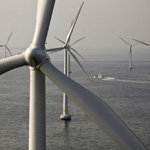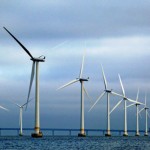
Ed Davey
While debate in the media rages on whether the UK’s green energy policies will raise electricity bills or not, Ed Davey, UK Secretary of State for Energy and Climate Change, has said that onshore and offshore wind power together cost householders only £18 a year in total, according to a Guardian article.
Moreover, Davey said that wind power is needed for the UK’s energy mix to insulate it from global gas prices: “Global gas price hikes are squeezing households. They are beyond any government’s control. The analysis shows that our strategy of shifting to alternatives like renewables and of being smarter with how we use energy is helping those who need it most to save money on their bills.”
The same article noted that UK government analysis published on Wednesday shows that 85% of the current average UK electricity bill (£1,250/year) cannot be controlled by the government because it is determined by international gas and electricity prices, transmission and metering costs.
 One of the world’s largest offshore wind farms came a step closer to reality in recent weeks as suction-installed foundations for the project left their Irish shipyard to begin their journey to the site of the Dogger Bank wind farm, 125 kilometres off the UK’s east coast.
One of the world’s largest offshore wind farms came a step closer to reality in recent weeks as suction-installed foundations for the project left their Irish shipyard to begin their journey to the site of the Dogger Bank wind farm, 125 kilometres off the UK’s east coast.
The structures, known as bucket foundations, can reduce costs as there is no need for transition piece costs or additional grouting as would be the case for more traditional foundations.
They are literally gigantic steel buckets that will sink solidly into the sea floor using a suction method and jetting systems, as opposed to floating or more conventional monopole, jacket or tripod foundations which are generally tethered to the seabed. –
 Still reeling from the earthquake and tsunami that destroyed the Fukushima nuclear plant in 2011, Japan has announced its intention to build what could become the world’s largest offshore wind farm.
Still reeling from the earthquake and tsunami that destroyed the Fukushima nuclear plant in 2011, Japan has announced its intention to build what could become the world’s largest offshore wind farm.
New Scientist reported last week that the world’s third largest economy plans to build by 2020 an offshore wind farm with 143 turbines 16 kilometres from the destroyed Daiichi nuclear reactor.
The new wind farm will generate 1 gigawatt of power once completed, the magazine said, adding it is part of a Japanese plan to increase renewable energy resources following the post-tsunami shutdown of the nation’s 54 nuclear reactors. Currently, two of those reactors have come back online.
“The project is part of the Fukushima region’s plan to become completely energy self-sufficient by 2040, using renewable sources alone,” the article said.

French ecology minister Delphine Batho
After months of uncertainty, French Ecology Minister Delphine Batho finally announced last week the second phase of a call for tenders for the construction of €3.5 billion worth of offshore wind farms to generate 1,000 megawatts of electricity.
The announcement followed up on a promise made by French Prime Minister Jean-Marc Ayrault during a government-hosted conference on the environment in September at which he and President François Hollande promised a plan to kick-start the renewables industry in France.
According to Batho, the projects will create 10,000 industrial jobs. The wind farms are planned for construction near Treport, in northern France, and near the Noirmoutier and Île d’Yeu islands on the Atlantic coast.
 Offshore wind farms can create a host of benefits for the local marine environment, as well as combatting climate change, a new study by the Marine Institute at Plymouth University has found.
Offshore wind farms can create a host of benefits for the local marine environment, as well as combatting climate change, a new study by the Marine Institute at Plymouth University has found.
The Marine Institute found that wind farms provide shelter to fish species since sea bottom trawling is often forbidden inside a wind farm, and it found that turbine support structures can create artificial reefs for some species.
A separate study at the Nysted offshore wind farm in Denmark confirmed this finding by saying that artificial reefs provided favourable growth conditions for blue mussels and crab species. A study on the Thanet offshore wind farm in the UK found that some species like cod shelter inside the wind farm.








 Comments
Comments



